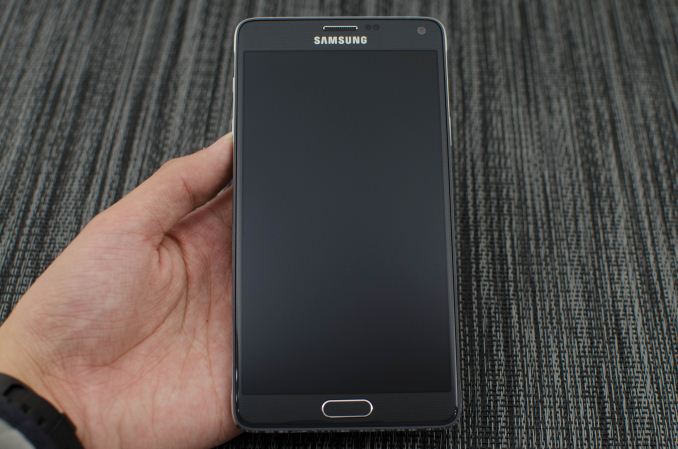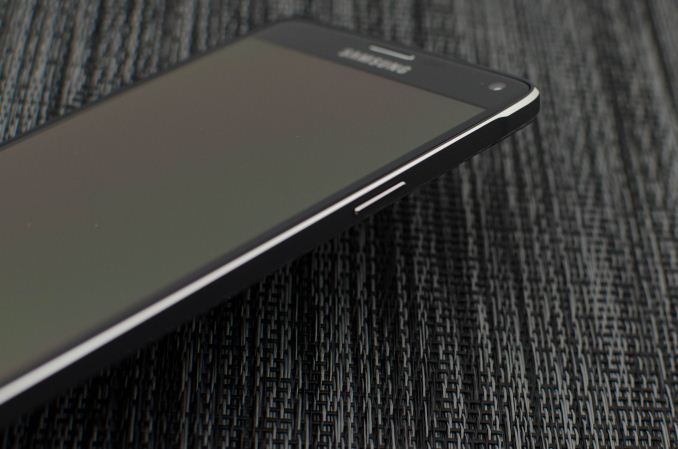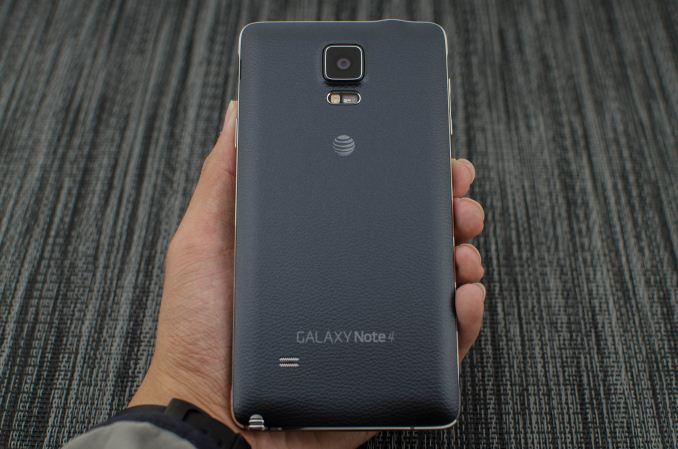The Samsung Galaxy Note 4 Review
by Joshua Ho on October 15, 2014 9:00 AM EST- Posted in
- Smartphones
- Samsung
- Android
- Mobile
- Galaxy Note 4

At this point, the Galaxy Note line needs little introduction. After all, the Galaxy Note is Samsung’s biggest success in mobile. While Apple redefined the smartphone and tablet segment, Samsung defined the phablet segment. Despite widespread skepticism, the original Galaxy Note was a massive success. Combined with the Galaxy S2, 2011 was a watershed year for Samsung as they leapfrogged other Android OEMs. Since then, we’ve seen continuous improvement from year to year with each Galaxy Note. While there were competitors, Samsung managed to hold on to their first-mover advantage for multiple generations. However, with the release of Apple’s iPhone 6 Plus we see one of the first significant threats to Samsung’s dominance of this segment.
The Galaxy Note 4 is Samsung’s latest iteration of the Galaxy Note phablet, and on the surface Samsung has put their best foot forward. With the highest bin of Qualcomm’s Snapdragon 805 or Exynos 5433, the latest generation AMOLED display, a 16MP camera with OIS, and a new design, the Galaxy Note 4 encompasses some of the best hardware that Samsung can deliver. I won’t spend too much time here, but the spec sheet below should cover most of the key points.
| Samsung Galaxy Note 3 | Samsung Galaxy Note 4 | |
| SoC | 2.26 GHz Snapdragon 800 | 2.7 GHz Snapdragon 805 |
| RAM/NAND | 3 GB LPDDR3, 32/64GB NAND + microSD | 3GB LPDDR3, 32GB NAND + microSD |
| Display | 5.7” 1080p Super AMOLED | 5.7” 1440p Super AMOLED |
| Network | 2G / 3G / 4G LTE (Qualcomm MDM9x25 IP block UE Category 4 LTE) | 2G / 3G / 4G LTE (Qualcomm MDM9x35 UE Category 6 LTE) |
| Dimensions | 151.2 x 79.2 x 8.3mm, 168 grams | 153.5 x 78.6 x 8.5 mm, 176 grams |
| Camera | 13MP Rear Facing, 1/3.06" CMOS size (Sony IMX135), 2.1MP FFC | 16MP Rear Facing w/ OIS, 1/2.6" CMOS size (Sony IMX240), F/2.0, 3.7MP FFC w/ F/1.9 aperture |
| Battery | 3200 mAh, 3.8V, 12.1 Whr | 3220 mAh, 3.85V, 12.397 Whr |
| OS | Android 4.4.2 with TouchWiz UX | Android 4.4.4 with TouchWiz UX |
| Connectivity | 802.11a/b/g/n/ac + BT 4.0, USB3.0, GPS/GNSS, MHL, DLNA, NFC | 802.11a/b/g/n/ac + BT 4.1, USB2.0, GPS/GNSS, MHL, DLNA, NFC |
| SIM Size | MicroSIM | MicroSIM |
While all of these things are easily discovered, the most immediate impressions always come from the design of the phone. In this respect, Samsung has done a surprisingly good job. On the front of the phone, we see a relatively standard design for Samsung. This entails a pattern on underneath the glass, which appears to be a bit shimmery in nature, along with dark black pinstripes. This causes a noticeable pattern in the capacitive buttons when lit, as with the LED notification light. There’s the standard earpiece and Samsung logo on top of the display, and a home button on the bottom, which serves as a fingerprint scanner as well. This home button is noticeably clicky in nature, and feels much better than the Galaxy Note 3’s home button.
On the sides, we see a similar level of improvement. The volume rocker, which is on the left side, and power button, which is on the right side, feel fantastic in comparison to most phones, and is quite close to the iPhone 6 and 6 Plus in feel. Unlike most Galaxy smartphones, we see an aluminum frame that runs all along the side of the phone, which also has a chamfered edge to eliminate sharp edges. In this area, Samsung has made serious strides as the frame really helps to make for a better in-hand feel that far exceeds what we saw with the Galaxy Note 3 or even the Galaxy S5. Along the top of the frame are cutouts for the 3.5mm headphone jack and IR port which enables TV remote functionality. Along the bottom of the frame, we see the microUSB 2.0 port. While this is technically a regression from the microUSB 3.0 port in speed and power delivery, I suspect compatibility issues and the ungainly design of the microUSB 3.0 standard justified a move back, at least until USB Type-C is ready for shipping devices.
On the back of the phone, we see some more changes. Instead of the downward-firing speakers of the Galaxy Note 3, we see that the speaker has been moved to the back of the phone. The design of the back cover is more an evolution of the Note 3’s back cover than the Galaxy S5’s, which has a noticeable faux leather pattern although the feel is closer to soft touch plastic. There’s also no stitching to try and make it seem more like leather. Instead, at the edges it seems to meet with the metal frame. A similar level of fit and finish is seen around the LED flash module, which is now flush with the back cover instead of sunk into the phone as with the Galaxy S5.
Overall, the design of the Galaxy Note 4 is massively improved. While it isn’t quite as amazing as the rounded design of the iPhone 6 and 6 Plus, it’s one of the best designs I’ve seen for a phone with a removable back cover. The only complaint I have is that Samsung should use a flat black pattern under the glass to accentuate the high contrast of the AMOLED display, but this is quite minor in nature.












195 Comments
View All Comments
KPOM - Wednesday, October 15, 2014 - link
It looks like they focused on the design and the display this time. I like the trend away from over saturated displays.mkozakewich - Wednesday, October 15, 2014 - link
No, they used movie mode. I didn't catch if they went there from where they were.Really, though, a larger gamut is a strength. All we need is for OEMs to create profiles so that we don't have the weird problems we had. They can create an sRGB profile, and an AdobeRGB profile, too. Then, when Android finally supports proper colour systems, they'll be able to introduce that immediately.
Wolfpup - Wednesday, October 15, 2014 - link
Disappointed that this isn't waterproof like the Galaxy S5 and S5 Active. I'd get the S5 just because of that.Samus - Wednesday, October 15, 2014 - link
Waterproof phones have never proven a big hit with consumers. The Kyocera Hydro and Galaxy S5 have a lot of inconvenient plugs and gaskets, with harder to press buttons. Then there is the added weight of the Active. There is always an Achilles heel to mil spec implementation.But it's good consumers have the option of waterproof devices, I just don't think the Note 4 being waterproof would be a compelling feature. I mean, if you drop the thing in the urinal its so big chances are the toilet cake would prop it up...and it's probably not on every sailors list of devices to have something so big.
Hrel - Wednesday, October 15, 2014 - link
There's also the fact that it's not very important to most people, if you'll be by water on a boat or something a $10 bag/case will do. Or hell, even a ziplock bag really. If it's a major concern for you then you're probably willing to spend the $100 on micro-sealing.petar_b - Wednesday, October 15, 2014 - link
I see waterproof feature it more like investment into protecting the investment rather than a feature. I would pay $100 on micro-sealing - just to be sure: if I am walking on the rain (following GPS), or phone accidentally falls in a puddle, or my kid accidentally drops it in the bath that it would survive. And protection bags are ugly, can't go on meeting with that, can't put on/off all the time. Additional frames to protect the screen or side sealing do reduce GPS signal; so no after market solutions.darkich - Wednesday, October 15, 2014 - link
I think the lack of water resistance is actually the result of the stylus slot. I could be wrong, but it seems somewhat logical that waterproofing such design would be difficultTams80 - Thursday, October 16, 2014 - link
I don't think so, unless the plastic of the stylus slot couldn't be impermeable (something to do with thickness?). It uses Wacom Penabled technology, so it should be possible (the Fujitsu Q584 has some water resistance with such a AD stylus).darkich - Wednesday, October 15, 2014 - link
I think the lack of water resistance is actually the result of the stylus slot. I could be wrong, but it seems somewhat logical that waterproofing such design would be difficultrobinthakur - Wednesday, October 15, 2014 - link
Disappointing really, not much wow factor here even if the materials have improved it just looks like a large Galaxy 5 with even less items of interest. Guess I will stay with the iPhone 6 plus.